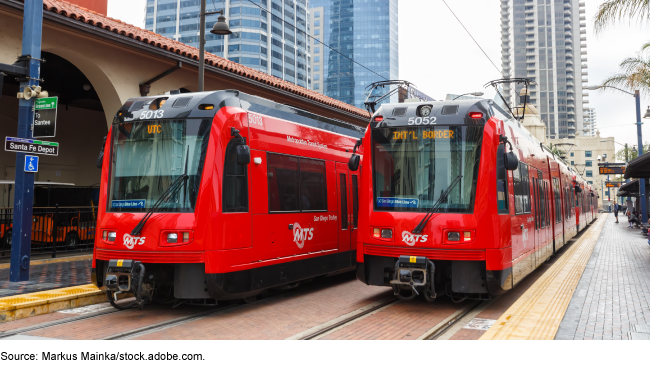Capital Investment Grants Program: Cost Predictions Have Improved, but the Pandemic Complicates Assessing Ridership Predictions
Fast Facts
The Federal Transit Administration's Capital Investment Grants program helps cities, states, and localities build transit systems such as commuter rail.
Grant applicants must develop capital cost and ridership predictions. FTA uses the predictions to help select projects and to later determine if a project delivered expected results.
FTA has developed methods to help applicants make better predictions, such as by assessing how various factors may affect costs. The accuracy of the predictions has improved over time. However, the pandemic changed people's commuting habits and, as a result, complicates assessing ridership predictions.
Santa Fe Depot station in San Diego, California

Highlights
What GAO Found
The Federal Transit Administration's (FTA) Capital Investment Grants program helps cities, states, and other localities across the country plan and build transit systems. FTA assesses the outcomes of these projects—which include heavy and light rail, commuter rail, streetcars, ferries, and bus rapid transit—in periodic Predicted versus Actual reports. FTA has issued four such reports, which examined projects that began operations from 1983 through 2015. To develop these reports, FTA used information on five types of project outcomes discussed in “Before and After” studies that project sponsors conduct (see figure). In the reports, FTA compared completed projects' actual capital costs and ridership with the outcomes project sponsors predicted. FTA's reports indicate that project sponsors' predictions of capital costs and ridership have improved. In the 2020 report, FTA found that about 86 percent of the projects discussed had actual capital costs within 10 percent of predicted costs and 48 percent of the projects had actual ridership within 20 percent of predicted ridership.
Transit Project Information That Sponsors Include in Their Before and After Studies

FTA has developed some methods to help project sponsors more accurately predict capital costs and ridership. For example, FTA conducts risk assessments to determine the probability that various factors will affect the project's costs, and project sponsors use this information to modify cost estimates. FTA also has developed an alternative approach to predicting ridership that enables project sponsors to use existing sources of data to quickly develop ridership forecasts.
Sponsors of two of the eight projects GAO reviewed have completed a Before and After study. These two sponsors reported their capital costs were 14 percent and 9 percent lower than predicted due to an unexpectedly favorable bid environment and untapped contingent funds. Both sponsors reported actual ridership was about 30 percent lower than predicted due to overly optimistic travel model assumptions. Sponsors for the other six projects were at various stages of compiling information and drafting their studies. According to all eight project sponsors, transit ridership declined precipitously at the start of the pandemic. In most cases, recovery has been slow. Sponsors said they expect ridership to continue to be lower than pre-pandemic levels, given the current trend of remote work. The significant impact of the pandemic complicates assessments of the accuracy of sponsors' pre-pandemic ridership predictions.
Why GAO Did This Study
FTA's Capital Investment Grants program is the primary source of federal support for transit projects that are locally planned, implemented, and operated. Project sponsors that apply for grant funding develop capital cost and ridership predictions. Later, FTA uses these predictions to help determine whether the projects have delivered expected outcomes. Accordingly, it is important that project sponsors predict these outcomes as accurately as possible.
The Infrastructure Investment and Jobs Act includes a provision for GAO to biennially review FTA's implementation of the Capital Investment Grants program. This report discusses: (1) FTA's efforts to assess project outcomes and help project sponsors more accurately predict outcomes and (2) the extent to which recent projects achieved predicted outcomes, and the factors associated with differences between predicted and actual outcomes.
To address these objectives, GAO reviewed relevant laws, FTA's guidance, and FTA's analyses of predicted and actual outcomes for projects that began operations from 1983 through 2015. In addition, GAO identified eight CIG projects that began operations from 2016 through 2021, reviewed available information about the projects, and interviewed FTA and project sponsors. The eight projects were from central Florida, Charlotte, Denver, Fort Worth, New York, San Diego, Seattle, and Silicon Valley.
For more information, contact Andrew Von Ah at (202) 512-2834 or VonAH@gao.gov.
